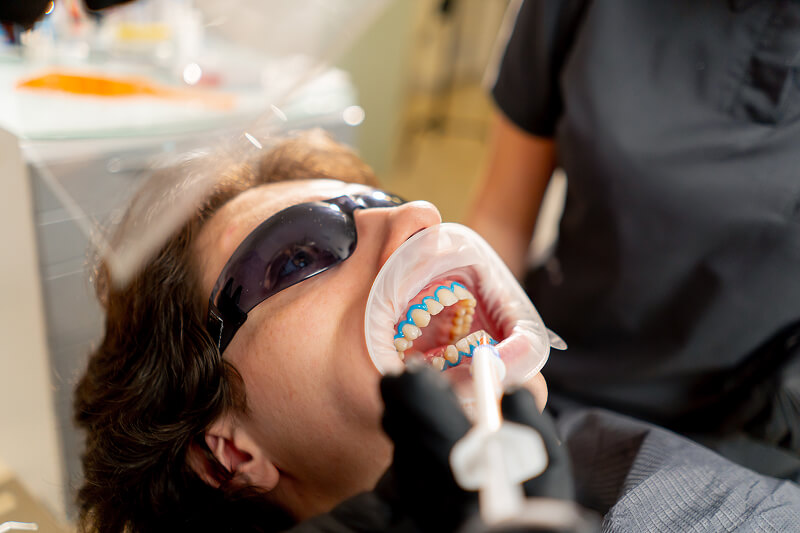Fixing a loose dental crown can feel daunting, leaving many wondering how such an integral part of their oral health unraveled.
We recognize that urgency and anxiety that comes with it. That's why we've assembled a guide to navigate your next steps in the Cookstown area:
- Understand the causes behind fixing a loose dental crown.
- Spot signs early to prevent future dental problems.
- Learn immediate actions to secure your dental health.
Understanding Dental Crowns and Their Importance
A dental crown isn't just another piece in your oral health jigsaw; it's a significant player in safeguarding your dental wellbeing. Crowns restore strength, size, and shape to damaged teeth, helping them function smoothly and look natural.
Different materials like porcelain, ceramic, metal, and resin come into play, each with unique advantages. Porcelain and ceramic provide a more natural appearance, while metal ensures durability. Resin is often a cost-effective option. With the right care, these durable solutions typically last between 5 and 15 years.
So, why does this matter to you? Dental crowns are key not only in protecting weakened teeth but also in enhancing functions like chewing and speaking clearly. They play a crucial role in comprehensive dental work, impacting everything from appearance to daily usability. This makes selecting the right crown and maintaining it properly essential for long-term success.
The Role of Crowns in Dental Health
Crowns contribute significantly beyond mere aesthetics. When you encounter a cracked or severely decayed tooth, crowns step in as the defensive layer, ensuring your teeth can endure everyday activities. In conjunction with procedures like implants or large fillings, crowns bolster the effectiveness and longevity of dental repairs, enhancing both health and appearance.
Dental crowns are silent achievers, fortifying your smile and daily life with reliability and sophistication.
Common Causes for a Loose Dental Crown
Understanding why a dental crown might become loose is important for prevention and timely intervention. Factors ranging from normal wear to lifestyle choices can lead to this issue.
Why Crowns Become Loose
- Wear and Tear Over Time: Even with the best materials, adhesives lose their grip over years of use. Regular dental check-ups can mitigate these risks.
- Tooth Decay Beneath the Crown: If the underlying tooth structure changes due to decay, the crown can feel unstable.
- Teeth Grinding: Constant pressure from grinding wears on the crown's stability, making regular monitoring crucial.
- Dietary Factors: Sticky or hard foods can pull or crack a crown, highlighting the need for dietary mindfulness.
Each cause links directly to choices or conditions we face daily, underscoring the need to remain vigilant about oral hygiene and dental visits.
Environmental and Lifestyle Impacts
Daily habits play a pivotal role in the stability of your crowns. From how you eat to maintaining a robust oral hygiene regimen, each element influences crown health. Recognizing these factors gives you the power to prevent unwanted looseness and extend the life of your dental work.
Identifying the Signs of a Loose Crown
Recognizing the signs of a loose crown can prevent further complications. Some indicators are easy to spot, while others might require a more careful look.
Key Indicators
- Sensitivity: Sudden sensitivity to hot or cold substances might signal looseness, revealing exposure.
- Movement: You might feel or notice the crown shifting when you bite down.
- Discomfort: A constant feeling of discomfort could hint at an unstable crown.
- Visual Changes: New gaps between the crown and gumline are clear signs of loosening.
These warning signals invite proactive measures. By spotting them early, you can address issues before they escalate, protecting your smile's functionality and appearance.
The Importance of Regular Monitoring
Routine dental visits offer crucial checkpoints for identifying and addressing crown-related issues. Through ongoing care and monitoring, potential problems are caught early, preserving your dental health with minimal interventions.
Early identification of a loose crown prevents the domino effect of further dental complications, ensuring continued comfort and confidence in your oral health.
Understanding your dental crowns and the reasons they might loosen empowers more effective care and timely action. Keeping a keen eye on warning signs allows for early interventions, bolstering the longevity and efficacy of your dental restorations.
Immediate Steps to Take if Your Crown is Loose
When your dental crown comes loose, quick action is crucial to prevent further complications. By taking the right steps immediately, you can protect your dental health effectively.
Actions to Stabilize Your Crown
- Avoid Chewing on the Affected Side: This minimizes additional stress and potential damage to the loose crown.
- Opt for Soft Foods: Stick to foods that are gentle on your teeth to avoid exacerbating the issue.
- Use Dental Cement as a Temporary Fix: Over-the-counter dental cement can offer a short-term solution until you see your dentist.
- Manage Discomfort: Over-the-counter pain relief like ibuprofen can help alleviate any discomfort you're experiencing.
These initial actions aim to maintain the condition of the crown and ensure your comfort until professional help is available.
Post-Looseness Care
Beyond immediate actions, it's vital you manage your mouth environment to avoid further loosening. Rinsing with warm salt water can provide relief and reduce the risk of infection. Schedule an appointment with your dentist to properly address the issue and restore your crown securely.
In situations like this, proactive care and swift professional intervention guard against escalation and ensure your dental restoration is handled efficiently.
Seeking Professional Dental Intervention
Professional care is essential when dealing with a loose dental crown. Seeing a dentist promptly ensures the best outcome for your dental health.
Why Professional Assessment Matters
Dentists can identify the underlying causes of crown problems. Whether it's decay, a structural issue with the crown, or something else, they have the tools and expertise to pinpoint the root of the problem.
During a dental visit, evaluations might include checking the fit of the crown, looking for signs of decay, or assessing the need for replacement or re-cementation. Timely treatment will not only save the crown but can also prevent more extensive dental work in the future.
Benefits of Regular Check-Ups
Regular dental visits play a significant role in maintaining crown integrity. These check-ups allow for monitoring changes in your teeth and crowns, catching potential issues before they become significant problems.
Investing in periodic reviews and cleanings fosters long-term health, ensuring your dental investments stand the test of time.
Early intervention can transform a potential headache into a manageable situation, maintaining confidence in your oral health and daily activities.
How to Prevent Future Issues With Dental Crowns
Prevention is a key strategy in securing the longevity and effectiveness of your dental crowns. By adopting thoughtful habits, you can minimize risks and keep your smile robust.
Effective Habits for Longevity
- Adopt a Strong Oral Hygiene Routine: Brushing twice and flossing daily is your first defense against decay and plaque.
- Regular Dental Visits: Periodic check-ups allow for professional cleaning and monitoring of crown conditions.
- Dietary Monitoring: Avoid particularly hard or sticky foods that might compromise crown stability.
- Consider a Mouthguard: If you grind your teeth, a custom mouthguard can help protect your crowns from unnecessary stress.
Each strategy focuses on minimizing wear-and-tear and extending your crown's life.
Lifestyle Changes That Make a Difference
Small lifestyle adjustments can also provide significant benefits. Avoid habits like nail-biting or using teeth as tools, which can destabilize a crown. The comprehensive approach emphasizes preserving both your oral health and the integrity of your dental work.
Conclusion
Understanding and acting on the factors that affect your dental crowns can transform a potential problem into a manageable condition. With the right steps, from recognizing signs and taking immediate action, to utilizing professional dental expertise and preventive habits, you can ensure your dental crowns remain secure and functional.
Monitor your crowns regularly and seek timely advice to maintain that winning, confident smile for years to come.

